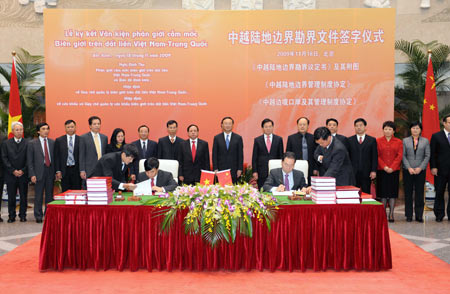China, Vietnam make border progress
China and Vietnam signed a package of agreements on the demarcation of their 1,300-kilometer land boundary Wednesday.
 |
|
Chinese Vice Foreign Minister Wu Dawei (2nd R, front) and his Vietnamese counterpart Ho Xuan Son (2nd L, front) sign a package of agreements on the demarcation of 1,300-kilometer land boundary between China and Vietnam in Beijing, capital of China, Nov. 18, 2009. Chinese Foreign Minister Yang Jiechi (C, second row) also attended the signing ceremony.[Ding Lin/Xinhua] |
Vice Chinese Foreign Minister Wu Dawei and his Vietnamese counterpart Ho Xuan Son inked these agreements on behalf of the two governments. Chinese Foreign Minister Yang Jiechi attended the signing ceremony.
The agreements include a protocol on demarcation of the land boundary, an agreement on land boundary management regime and an agreement on land port and its management regime.
The two vice foreign ministers held talks before the ceremony, during which they agreed to further the coordination and cooperation in land border affairs and work to achieve lasting peace, security and mutual development along the border areas.
They also reiterated that the two countries will try to solve the sea issue through diplomatic negotiation. They agreed to jointly maintain peace and stability of the South China Sea and start consultation to formulate the guidelines to solve the sea issue.
China and Vietnam signed land boundary treaty in 1999 and set up a joint committee for land border demarcation two years later.
In late 2008 the committee completed the demarcation along the entire length of China-Vietnam land border with about 2,000 border markers erected.
The 1,300-kilometer China-Vietnam border starts at the junction of China, Vietnam and Laos and continues along the Beilun River to the coast. Yunnan Province and Guangxi Zhuang Autonomous Region are on Chinese side, and Cao Bang, Lang Son, Dien Bien, Lai Chau, Lao Cai, Ha Giang, Guang Ninh are in Vietnam.
 0 Comments
0 Comments






